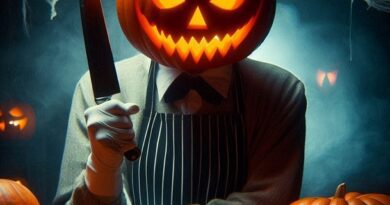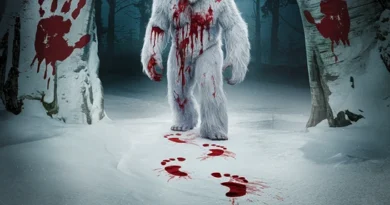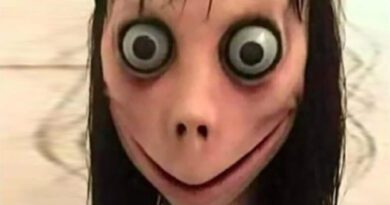Green Horror: Is The Leprechaun An Innocent Irish Mythological Creature, Or A Scary Villain?
Irish mythology is diverse and full of frightening creatures, or at least with the potential to be so. Among the supernatural creatures at the heart of Irish mythology, one can find the leprechaun, who managed to cross the borders of local culture and become one of the familiar symbols of Irish folklore, one that appears on tourist products, takes part in St. Patrick’s Day celebrations, appears on thousands of products, and stars in several tourist attractions in the country. However, over the years, this small and lovable creature (at least seemingly), with its green clothing and red beard, has, of course, found its place in the world of horror – also thanks to a series of films, quite mediocre to be honest, that bear its name.
As is our holy habit in the mythological horror section, we decided to once again present you with the dark side of one of the most well-known ancient creatures from Ireland, a country known for the wide variety of supernatural creatures it has brought to the world. Here is everything you need to know about the creature. We will start with some scary leprechaun facts, continue with his significane in many fields and finish with a list of leprechaun horror movies.
Some Creepy Fun Facts About Leprechaun
What Is A Leprechaun?
The Leprechaun is a mythical creature from Irish folklore. They are seen as human-like, but have a clear supernatural character. In most descriptions, they have a red or white beard and a sly or mischievous look, suggesting they are not entirely innocent.
Leprechauns are described in Irish tradition as tiny creatures, but how tall is a leprechaun really? According to most descriptions, it is about 50-100 cm tall and sometimes as tall as 1.5 m.
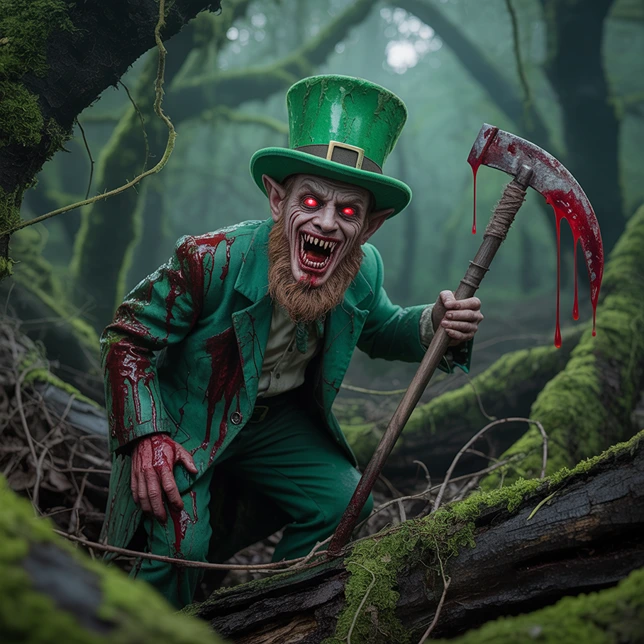
What Does A Leprechaun Wear?
Leprechauns’ clothes have become one of their hallmarks over the years. Among other things, you will find them wearing a green coat or suit, shorts, high socks, and black shoes with a silver or gold buckle. On their heads, they wear a tall hat, sometimes a green top hat, and sometimes an older version of a red hat. The wide belt with a metal buckle is another detail that appears in almost all illustrations.
In many descriptions, leprechauns wore leather aprons, a silver belt, or tools, in a manner that corresponded to their traditional profession as shoemakers. It is said that sometimes an approaching leprechaun can be identified by the sound of a small hammer tapping on a sole.
Things The Leprechaun Does For A Living
Alongside this occupation, they are also known for their association with hidden treasures: according to legend, each leprechaun hides a pot of gold at the end of the rainbow. Whoever captures a leprechaun may demand that he reveal the location of the treasure. Still, the task is almost impossible because the creature is agile and sophisticated, finding various ways to evade. Some would argue that their main job was to sew fairy shoes. In some descriptions, the claim was that leprechauns were not shoemakers by profession, but rather people who frequently repaired their own shoes because they ran so much and wore them out quickly.
In other cases, leprechauns were referred to as dwarf demons who lived above ground and collaborated with humans, or at least were employed by them. They were described as creatures that lived in relatively dark places, such as cellars or wineries, and performed various tasks that humans needed. In exchange for these tasks, they received a reward, often valuable objects or coins.
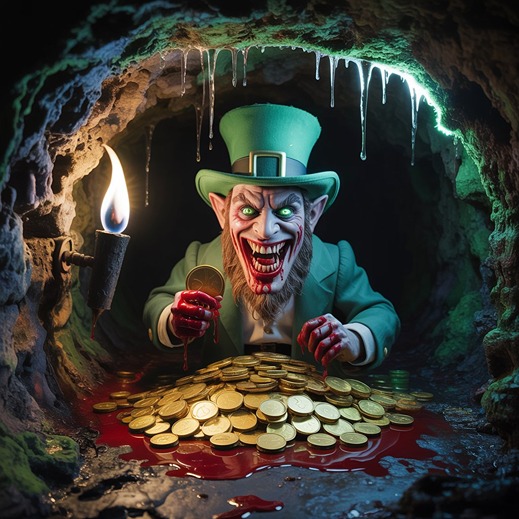
Why Are Leprechauns Green?
The history of leprechauns shows that their physical appearance has evolved over the years. In the first descriptions, from the fourteenth century, it was described as a small creature, but not necessarily green, sometimes seen in shades of red or brown.
The inseparable association with the color green was strengthened as Irish national identity consolidated, with green becoming a symbolic color. Nevertheless, in different regions of Ireland, we have seen the development of distinct myths, including a character with leprechaun-like traits.
What Does The Leprechaun Name Mean?
There is no consensus today about the origin of the name “leprechaun”. A renowned Irish historian and linguist named Patrick Deneen analyzed that the origin of the name is in the Irish word “Luchorpan”, whose direct translation is “dwarf”, or “elf who lives near water sources”. Other interpretations refer to the small dimensions of the leprechaun’s body (“half body” or “small body”), while others refer to his profession as a “shoemaker elf”.
💀 Killer Deals & Scary Recommendations 💀
🎭 Costumes & Accessories
HalloweenCostumes Fun Costumes Entertainment Earth
🛒 Online Shopping
AliExpress Amazon Walmart Etsy
🧛 Collectibles & Horror Brands
Funko Hot Topic Lego Spirit Halloween
🎢 Attractions & Tours
GetYourGuide Tiqets Viator Klook
📖 Blogs & Horror Sites
Bloody Disgusting iHorror Fangoria
🩸 Disclaimer: Some links are affiliate links. The price stays the same – it just helps keep the site alive 👻
Annoying, But Not Harmful: The Traditional Nature Of Leprechauns
According to much of Irish folklore, leprechauns are mischievous creatures who like to play pranks but are not evil or harmful (which, of course, changes in horror films, which we will discuss later). Still, some have attributed leprechauns’ acts of deceit and fraud to greed.
The character is known for his fondness for green – no, just the colors of the Irish flag – and for collecting treasures, which they hide well. Legend has it, on the other hand, that where the rainbow touches the ground, you can find clues to the location of the leprechaun’s treasure. In many descriptions, leprechauns are portrayed as wealthy, thanks to the discovery of a “buried treasure urn in ancient times”. They are in a compulsive search for such treasures or at least guard them, which is a very colloquial version of letting the cat keep the cream.
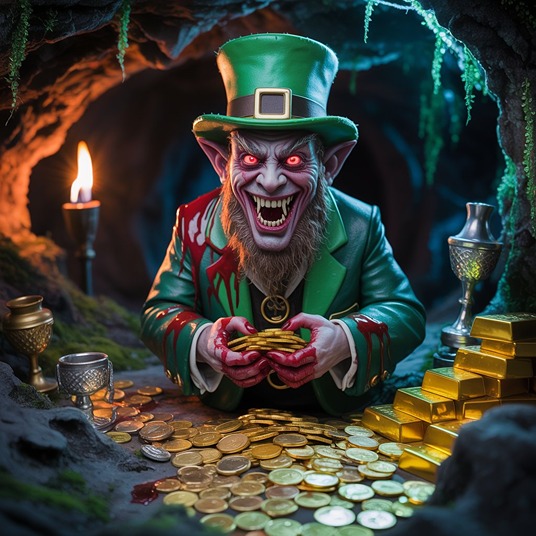
While leprechauns are often associated with wealth and good luck, some myths warn that they are dangerous. The claim is that leprechauns may bestow gifts or direct us to some treasure, but they are not truly generous. Interactions with them may be accompanied by tricks, so that the person who thought he would benefit from them may find that he ultimately lost out.
In most descriptions, the leprechaun is a relatively solitary character who prefers to avoid civilization and other creatures. He has a relative called the “Clurichaun”, who is considered a slightly wilder version of him with a fondness for nightlife, mass parties, and alcoholic beverages (well, he is Irish after all).
The Leprechaun Becomes One Of The Symbols Of Ireland
The leprechaun has undergone a fascinating journey, from a local folk figure to a national symbol recognized worldwide. The connection of the leprechaun to Irish identity was especially strengthened during the 18th and 19th centuries, when the Irish began to build a national identity separate from British rule. The green color, which became the main symbol of the leprechaun, merging with Ireland’s national green even earlier, in the 17th century, the leprechaun became a mythical representation of the Irish spirit.
The modern image of the leprechaun with the red beard and green hat is a relatively modern invention, or one that comes from other streams of European folklore. Various elements can reflect developments in those centuries across Europe, such as the traditional fashion style Irish immigrants wore when they arrived in the United States. The buckle shoes and other elements of the appearance come initially from the Elizabethan period in Ireland.
A significant change occurred with the waves of Irish immigration in the 19th century, especially to the United States. Irish immigrants brought their traditions, including the leprechaun, with them, but they also adapted them to the new environment. In the United States, the leprechaun took on a new, more commercial and “light” meaning, especially in the context of St. Patrick’s Day.
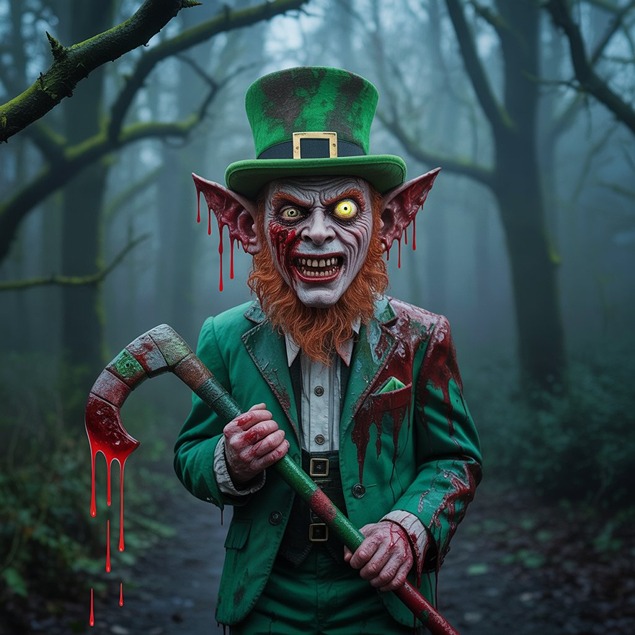
National Leprechaun Day, St. Patrick’s Day, And Everything In Between
St. Patrick’s Day, which has become a global celebration, played a significant role in popularizing the leprechaun as an Irish symbol. The colorful celebrations, street parades, and parties that take place around the world on March 17 have made the leprechaun a familiar figure even to those who have no connection to Irish culture. Hotels, pubs, and restaurants in Ireland began to use his image to attract tourists, and he became an integral part of the country’s tourism branding as “Enchanted Ireland.”
However, there is a separate day honoring the leprechauns themselves: National Leprechaun Day, celebrated every year on May 13. In many cases, National Leprechaun Day and St. Patrick’s Day are combined.
Tourist Attractions Following The Leprechaun In Ireland
Today, you can find leprechaun-themed tourist attractions in different locations across Ireland. The main attraction is the National Leprechaun Museum of Ireland, located in Dublin. The museum, which opened in 2010 as the world’s first museum dedicated to leprechauns, offers an interactive experience focused on the tradition of Irish storytelling and folklore.
Tom O’Reilly, who began working on the project in 2003, founded the museum and designed it in collaboration with two Italian designers. The museum is a tourist attraction that aims to introduce visitors to the mythical world of these famous little people and to emphasize the place of storytelling tradition in Ireland.
The museum tour is guided and passes through different rooms, each serving as a setting for a different theme. Visitors learn about the folklore of leprechauns and their representation in popular culture – for example, Walt Disney’s visit to Ireland that led to the creation of the 1959 film “Darby O’Gill and the Little People.” The museum features a tunnel filled with optical illusions, a wooden replica of the “Giant’s Bridge” rocks in Northern Ireland, and a room with giant furniture that makes visitors feel tiny. In addition, it has references to other creatures from Irish mythology.
The museum has received mixed reviews. In 2010, the Irish Times called it “the Louvre of Leprechauns.” In 2024, however, it appeared on solitaired.com’s list of the “100 Most Boring Attractions in the World” based on Google user reviews, ranking it a disreputable 38th. It was the only Irish site to make the list, leading the media to call it “Ireland’s most boring tourist attraction”.
Beyond the museum, there are smaller, local leprechaun attractions in Ireland: for example, in the village of Carlingford in northeastern Ireland, where you can visit the Leprechaun and Fairy Underground Cavern for a tour that includes stories about the mythical creatures and a visit to a cave full of legends. In various locations in Ireland, both in the big cities and in rural areas, you can go on tours that combine local myths and folklore, many of them with explicit references to leprechauns.
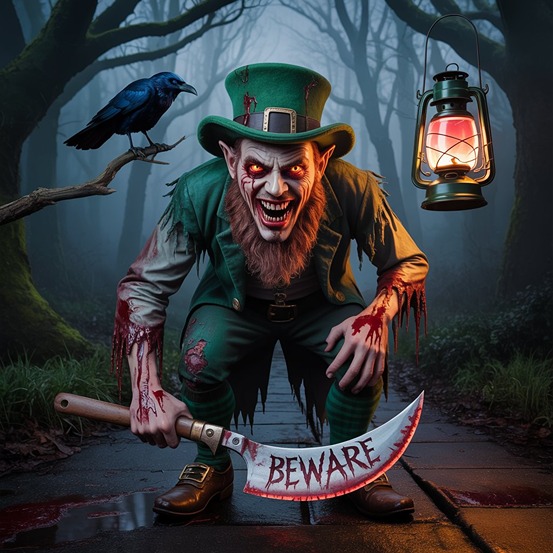
Leprechaun Products: An Economic Hit
The leprechaun’s transformation into a world-famous Irish symbol has spawned an entire industry of consumer products and decorations. The world of commerce has embraced the lovable character, and this can be seen in a long line of products, including:
![]() Leprechaun costumes are a must-have for St. Patrick’s Day celebrations and large-scale events like Halloween. You can find simple versions for babies and children, as well as adult and even sexy costumes.
Leprechaun costumes are a must-have for St. Patrick’s Day celebrations and large-scale events like Halloween. You can find simple versions for babies and children, as well as adult and even sexy costumes.
![]() Leprechaun Accessories – that connect to the Leprechaun myth, such as a fake beard, a green hat, shoes, a rainbow-shaped purse, a gold pouch, and the like.
Leprechaun Accessories – that connect to the Leprechaun myth, such as a fake beard, a green hat, shoes, a rainbow-shaped purse, a gold pouch, and the like.
![]() Leprechaun Sweaters (including ugly sweaters, of course) and pajamas featuring the magical creature.
Leprechaun Sweaters (including ugly sweaters, of course) and pajamas featuring the magical creature.
![]() Branded leprechaun shirts, mostly in black and green, sometimes with an illustration and some amusing message.
Branded leprechaun shirts, mostly in black and green, sometimes with an illustration and some amusing message.
![]() Leprechaun collectibles, such as Funko Pops or leprechaun horror action figures based on the evil leprechaun character from horror films.
Leprechaun collectibles, such as Funko Pops or leprechaun horror action figures based on the evil leprechaun character from horror films.
![]() Leprechaun Birthday Decorations or themed parties with an Irish flavor.
Leprechaun Birthday Decorations or themed parties with an Irish flavor.
![]() Leprechaun Jewelry, including pendants, earrings, and rings that feature his image or symbols related to him and Ireland (the pot of gold, the scepter). Some believe that the jewelry is not only a fashion item but also a good-luck charm.
Leprechaun Jewelry, including pendants, earrings, and rings that feature his image or symbols related to him and Ireland (the pot of gold, the scepter). Some believe that the jewelry is not only a fashion item but also a good-luck charm.
![]() Leprechaun Yard Decorations, such as giant inflatable leprechauns and garden gnomes with an Irish twist.
Leprechaun Yard Decorations, such as giant inflatable leprechauns and garden gnomes with an Irish twist.
Note: Some of the above links are affiliate links, meaning we may earn a small commition when you purchase through them.
The Leprechaun In Culture, Politics, And More
Movies, animated films, music videos, and advertisements have used the leprechaun image, with some locals claiming these are stereotypical or insulting representations, often based on anti-Irish cartoons. In any case, the leprechaun has become a symbol of several sports teams, such as the Notre Dame Leprechauns, the mascot of the University of Notre Dame’s athletics department in Indiana, United States. The symbol was designed in 1964 by the American graphic artist Theodore W. Drake (who also created the famous Chicago Bulls logo), and appeared that year on the cover of Time magazine. You will also find a leprechaun on the NBA team’s logo, the Boston Celtics, who goes by the name “Lucky.”
The food (and alcohol) industry has not stood still, with products bearing the leprechaun’s name or image. The best-known example is the breakfast cereal Lucky Charms, whose mascot is a lovable leprechaun named Lucky. You can find candies, ice cream, and beers that feature the leprechaun in one form or another.
Leprechaun has also become a coinage, like the term “Leprechaun Economy” used by Paul Krugman to criticize the fact that in the early 2000s, imposing growth figures were published in Ireland, with an exceptionally high gross domestic product, but in reality these figures mainly represent the country’s unusual tax system, which caused many companies – such as Apple – to record significant percentages of their profits there, as a tax haven. In Irish domestic politics, another example, those who supported the country’s union with Britain called opponents “leprechaun speakers”, an expression that should probably offend them.
How Many Leprechaun Movies Are There?
Today, we’ve learned that many mythological creatures – even those that are lovable or intended for children – undergo a twist in horror cinema, becoming murderous versions of themselves. Most of the scary leprechaun movies are from the “Leprechaun” franchise, which began in 1992 and includes eight films to date.
Leprechaun Horror Movies In Order
In the case of the leprechaun, this happened back in 1992 with “Leprechaun,” directed by Marc Jones. The film was about a 600-year-old leprechaun who was once imprisoned in a wooden box. A few years later, a family moves into the house, and in horror movies, moving to a new home is never a good thing. They accidentally release the leprechaun from the box, and he begins a killing spree.
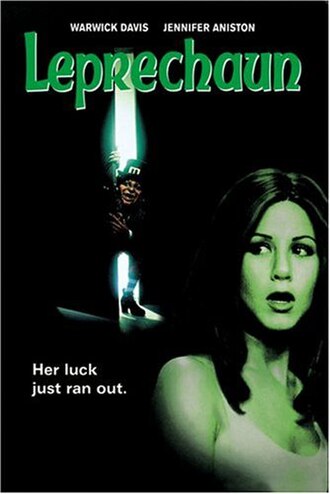
“Leprechaun” is actually Jennifer Aniston’s first significant film, and the only horror film in the filmography of someone who is known today mainly as a comedic actress (Rachel from “Friends”, of course, but also “We’re the Millers”, “Marley and Me”, “Murder Mystery”, “Bruce Almighty,” and more). This leprechaun horror character was played English actor Warwick Davis, who suffers from dwarfism, who you may know as the short, warrior farmer in Ron Howard’s “Willow” (1988), as the spell teacher Professor Filius Flitwick (and also a goblin character) in the “Harry Potter” films or in relatively minor roles in films like “TThe Chronicles of Narnia: Prince Caspian” and “Star Wars – Episode VI: Return of the Jedi”.
The first “Leprechaun” film was produced on a meager budget of about $900,000 and received pretty mixed reviews. Despite this, it was a box office success, grossing over $8.5 million, and became a cult film. In 1994, the sequel, “Leprechaun 2,” also starring Warwick Davis, combined his murder spree with a search for a bride and gold. The film was released in theaters and grossed about $2.3 million, but received negative reviews.
The following films in the franchise have already been made directly for home viewing, and there have been quite a few of them: “Leprechaun 3” (1995), also known as “Leprechaun 3: In Vegas,” moved the action to Las Vegas. In “Leprechaun 4: In Space,” the leprechaun moved to outer space, and in “Leprechaun in the Hood” from 2000, he received a somewhat dark twist (the intention, of course, was only to make the film a black comedy). Then came “Leprechaun: Back 2 tha Hood,” also with a black twist, which was the last film starring Davis and the first under Lionsgate’s production.
Moving on to 2014 with “Leprechaun: Origins,” in which for the first time another actor stepped into the shoes of the Irish leprechaun: the American wrestler and YouTube star Dylan Mark Postl, better known by his stage name “Hornswoggle” – a name that represents a leprechaun character. The film, according to the creators, was supposed to be a little darker and more traditional than the Warwick Davis films. The audience was less impressed, and it currently has a score of 3.2 out of 10 on IMDb.
In 2018, the last Leprechaun film to date, “Leprechaun Returns,” arrived. The eighth film in the franchise was a direct sequel to the first and ignored all the unnecessary sequels that followed. The heroine here is Taylor Spreitler (“Days of Our Lives,” Melissa & Joey,” and “Amityville: The Awakening” alongside Bella Thorne), who plays the daughter of the character played by Jennifer Aniston in the first film.
The Irish elf was played this time by the 3’3″ Linden Porco, who suffers from a rare condition called Cartilage–hair hypoplasia that combines symptoms of dwarfism with completely normal development in other areas. When he was nine years old, the Canadian Porco played the double of Marlon Wayans, a dwarf criminal who poses as a baby to carry out his plot, in the movie “Little Man.” The film used a green screen technique, replacing Porco’s head with Wayans’s during editing, and even painting Porco’s body brown to match the actor’s face. Porco, by the way, also played the body double of none other than the doll Chucky in the 2017 film “Cult of Chucky.”

In 2025, another leprechaun horror film called “Leprechaun: The Beginning” was released, which at first glance might seem like something related to the original franchise. The plot of this low-budget film centers on a family that discovers a treasure box in the patriarch’s house, believing they’ve found the key to financial fortune. But very quickly, as you’ve probably guessed, the real owner of the box of gold arrives and starts murdering them one by one, in ways that are probably mostly low-budget. The film, which currently holds a score of 2.0 out of 10 on IMDB, was made independently of the original movies and is not related to them in terms of story, characters, creators, or anything else.
The creators probably used the myth of the Leprechaun – an ancient mythological figure, which is, of course, copyright-free – and perhaps tried to ride on the cult status of the original films (at least some of them) to create buzz. Or they just wanted to make a low-budget film about a familiar character to attract viewers. I haven’t seen the movie yet, but from the trailer and a few scenes I’ve seen, it isn’t a significant loss.


